Introduction to two 2016 BUS-eum tours, with an illustrated Project Outline to
At Home in the Heartland:
Forgotten Stories of How
Iowans Got to Be ‘Us’
Project Outline — What, Part I: exhibit on Midwest identity,
with workshop available
TRACES Center for History and Culture is pleased to begin accepting hosts for the spring- and autumn-2016 showings of its newest BUS-eum exhibit “At Home in the Heartland: Forgotten Stories of How Iowans Got to Be ‘Us.’”
The BUS-eum exhibit At Home in the Heartland: Forgotten Stories of How Iowans Got to Be “Us” examines how the Midwest developed in ways different from other regions, how Iowa’s settlement distinguished it from its neighbors, and what both blesses and burdens us today. While the exhibit supports visitor discovery and interpretation of Iowa history and culture, rather than trying to provide stock or “right” answers, it seeks to stimulate effective reflection on essential questions. (Additional mages of the BUS-eum are at http://traces.org/Buseum_3_tour/Buseum_3_Scenes.html)
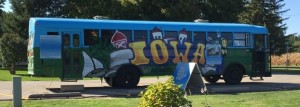 | 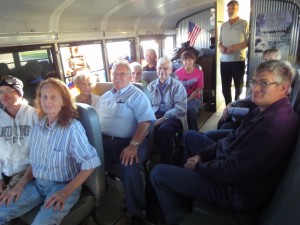 |
the BUS as parked in Le Grand, Iowa, by day (left) and Albion by evening in fall 2015
Typically, the BUS arrives half an hour before showing. After set-up, it shows for three hours—although some communities opt for double that. It requires a standard 110-wattage, three-prong outdoor outlet and a parking space at least fifty feet long—preferably curbside, as that assists easier access for seniors. TRACES supplies hosts or their teacher-partners with materials for schools, as well as a complete press package for PR use.
An hour after the exhibit in the BUS opens for viewing, TRACES director Michael Luick-Thrams offers one of several possible programs; hosts can pick from programming about Iowa history, family history, the refugee crisis now dividing Germany and Europe, or some other topic, agreed upon beforehand. In the auditorium in the BUS’ back, a handful of films featuring little-known Iowa stories run constantly.
Visiting all counties south of I-80 between 31 March and 22 May 2016, and those north of I-80 but west of I-35 in September 2016, it tells little or unknown and forgotten stories of who we have been in the past, how we got to be who we are now, and who we might yet become.
The exhibit and related programming respond to questions like:
- Who bestowed the name “Iowa” to the region between two great rivers—and why?
- What is the legacy of the ethnic groups who then settled the Hawkeye State?
- Why did Iowa (15 years after statehood!) send the most soldiers to the Civil War, per capita?
- Why did minorities usually fare better in Iowa than in some neighboring states? Why did the Underground Railroad operate in a state that had no slaves? What motivated that effort?
- Why did the Ku Klux Klan flourish here in the 1920s, despite generally tolerant conditions?
- How did “Penny Auctions” help save thousands of farmers during the Great Depression?
- How did Iowa Quaker farmers and college kids bring 185 refugees from Nazi-occupied Europe to the American Heartland, and how did they offer them a new life in the US? Why does it matter?
- What motivated Iowans to treat the 20,000 German POWs here in WWII so well during WWII?
more ... Before the BUS leaves a given community, hosts also can view a broad selection of books about Iowa published by TRACES or cooperating authors, which otherwise are not available to the public. Book sales both supply libraries or museums with rare works, as well as help fund TRACES’ on-going tours/projects. After showing the BUS and a half-hour-long take-down (totaling four hours of engagement at a given venue), the BUS sets off for the next showing, usually in a neighboring county. Some hosts opt for a “vertical” all-community showing, involving a local school, church, etc., resulting in an all-day event that engages different audiences, taps local people as participants and gives deeper focus to local issues. If two staff come for a four-hour engagement at one venue in a given community, we ask for $350 to cover our costs. If we give two showings in one town, we ask $300 each; $250 each for three sites. We can work with would-be hosts to find supplemental or alternative funding: We rarely decline offers to show the BUS based on a lack of money, as our goal is to tell stories and ask questions, not to get rich. 2016 BUS tours are underwritten by Humanities Iowa, the Hanson Foundation and Vander Haag’s Inc. looking at a past exhibit from the front to doorway (left) and from the auditorium to the front Because a community consists of individuals, most of whom hail from families, the curators believe that the seeds of a community lie in the family histories of the people who built or later inhabited a given place. Thus, during a morning exhibit showing, Michael Luick-Thrams offers a 90-minute workshop, “Roots of Darkness: Exploring the Social Contexts of Family History;” it encourages visitors to reconsider family legacies in the setting of larger histories, as a way to better understand the origins of their wider community and their connections to its people. To enhance the project’s impact, before the BUS visits a community, hosts can offer patrons (for example) pre-visit book discussions which could include virtual or real-time visits by featured authors—some profiles of whom are at http://roots.traces.org/programs.* Also, the panels include the experiences of women and Native-, African- and Hispanic-Americans. Local authors’ books are displayed in the BUS and are available as a way to feature local histories. In these and other ways, the exhibit not only distills but documents the experiences of Iowans, past and present. (*If TRACES’ director’s book Roots of Darkness is chosen, it focuses on Iowa social history from 1888-1980: see http://www.amazon.com/s/ref=nb_sb_noss?url=search-alias%3Daps&field-keywords=roots+of+darkness) As a here-today-gone-tomorrow project benefits no one, the exhibit’s designers not only offer pre-visit activities in preparation for a given BUS visit to a community, but also post-visit ones. We seek lasting relationships with both hosts of and visitors to our programming: Already, we enjoy decades-long ties to most target communities. Project Outline — What, Part II: program “Words between Worlds” After a half-day showing, HH ideally moves to a local high school or college. Volunteer seniors, parents or other community members accompany it to a short, introductory large-group program, then divide and meet with small groups of students in 20-minute sessions, first to speak in-depth about their experiences with themes (which students choose beforehand), then to field students’ questions. (TRACES works with the Iowa Genealogical Society, AARP-Iowa, Iowa Retired School Personnel Association, NIACC’s Lifelong-Learning Institute and that of other regional community colleges, plus hosts to recruit speakers; while hosts ultimately are responsible for coordinating the list of speakers, TRACES can help find and orient them, pre-event; BUS staff help coordinate speakers at the schools.) An entire class can fit in the BUS’ “auditorium” (left) or the program can be moved indoors. Educators can access teaching materials before a BUS visit. To reinforce critical-thinking skills, the downloadable guides help students see their guests’ narratives and comments in wider contexts, as well as offer them tips on active listening and effective questioning. Students may visit multiple sessions. Special display cases fit the space available and contain exhibit-relevant artifacts or props. Project Outline — What, Part III: public forum, with inter-generational dialogue In the evening, a facilitated program (held at a third partnering venue, such as at a church, city hall, a civic or fraternal club’s building) can provide community members of all ages, as a group, time and space for inclusive public discussion. Reflecting on historical themes from the exhibit as well as themes the students explored with seniors or other adults at the school, the third program affords a brief review before eliciting inter-generational exchange about a community’s possible local futures. more ... The BUS served as a mobile museum, including “auditorium,” display space and “couchette” long before being repainted for the current exhibit. Project Outline — How A “typical” BUS-eum day follows below; in reality, times or components can be shifted, added, etc.: Preserving and interpreting local history does not depend only on offering the general public exhibits or events, but on strengthening the vitality of history- and culture-focused institutions operating on the local level. For that reason, on two weekends, the community forum will be replaced by conferences, Facing Inconvenient Truths: How Museums Might Survive, Even Thrive, Despite Shifting Demographics and Shrinking Resources. Participants will include staff from county historical societies, “niche” (e.g., ethnic, military and specialty) museums, etc. While the conference will open with comments from social-historian Michael Luick-Thrams, it will build upon input from local consultants and attendees, and include roundtable discussions. It will focus on re-purposing premises or projects; leveraging existing collections, staff, volunteers and other resources; drafting new interpretation guidelines and goals; networking with complementary organizations; and honing best-practice strategies for strengthening local museums. TRACES staff currently are in the process of confirming those events. For more information about our organization and its present as well as past programs, see www.roots.TRACES.org or www.TRACES.org. Project Outline — Who artifacts and period props from the exhibit about German POWs in the Midwest, 1943-46 Project Outline — When and Where Counties/cities* visited in September-November 2015 included these, located north of Interstate 80 and east of Interstate 35: more ... Black Hawk, Cedar Falls Boone, Boone Bremer, Waverly Butler, Greene Cedar, Tipton Cerro Gordo, Clear Lake & Mason City Clay, Spencer Clayton, Elkader Clinton, De Witt Dubuque, Dyersville Fayette, Fayette Floyd, Charles City Franklin, Hampton Grundy, Wellsburg Hamilton, Webster City Hancock, Garner Hardin, Eldora Howard, Cresco Iowa, Marengo Jasper, Newton Marshall, Marshalltown, Albion, State Center & Le Grand Scott, Davenport Story, Ames Tama, Tama Winnebago, Forest City Winneshiek, Decorah Worth, Northwood Wright, Belmond In April and May 2016, the BUS-eum will tour to 40 communities in 32 Iowa counties, all south of Interstate 80. Target towns include: more ... Adams, Corning Appanoose, Centerville Benton, Vinton Cass, Atlantic Cass, Griswold Clarke, Osceola Davis, Bloomfield Decatur, Leon Des Moines, Burlington Douglas, Omaha, NE Fremont, Sidney Henry, Mount Pleasant Jefferson, Fairfield Johnson, Iowa City Keokuk, Sigourney Lee, Fort Madison Lee, Keokuk Louisa, Wapello Lucas, Chariton Madison, Winterset Mahaska, Oskaloosa Marion, Knoxville Marion, Pella Mills, Glenwood Monroe, Albia Montgomery, Red Oak Muscatine, Muscatine Page, Clarinda Page, Shenandoah Pottawattamie, Council Bluffs Ringgold, Mount Ayr Taylor, Bedford Union, Creston Van Buren, Keosauqua Wapello, Ottumwa Warren, Indianola Washington, Washington Wayne, Corydon In September 2016, the BUS-eum will tour to 30 communities in 25 Iowa counties, north of Interstate 80 and west of Interstate 35. Targets include: more ... Audubon, Audubon Buena Vista, Storm Lake Calhoun, Rockwell City Carroll, Carroll Cherokee, Cherokee Crawford, Dennison Dallas, Perry Dickens, Spirit Lake Emmet, Estherville Greene, Jefferson Guthrie, Guthrie Center Harrison, Logan Humboldt, Humboldt Ida, Ida Grove Lyon, Rock Rapids Monona, Mapleton O’Brien, Primghar O’Brien, Sheldon Osceola, Sibley Plymouth, LeMars Pocahontas, Pocahontas Sac County, Sac City Shelby, Harlan Sioux, Orange City Sioux, Sioux Center Webster, Fort Dodge Woodbury, Correctionville Woodbury, Sioux City 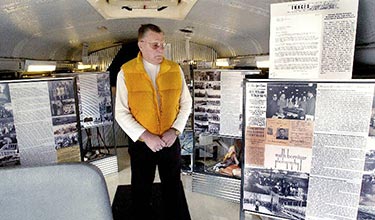
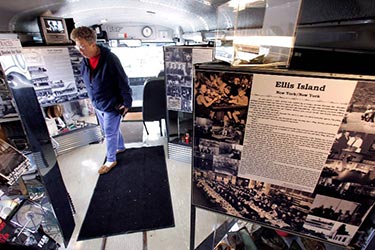
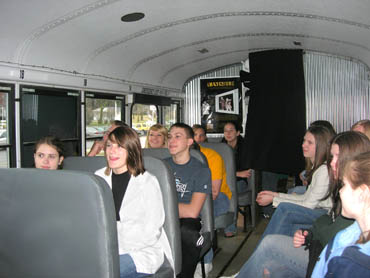

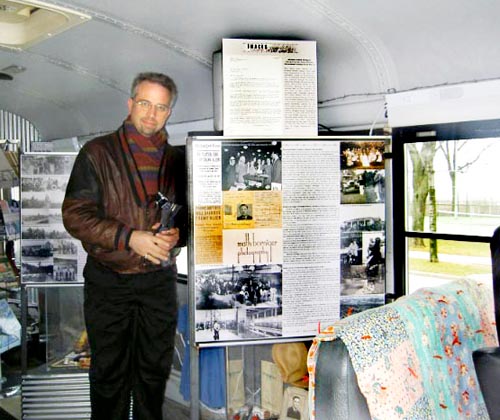
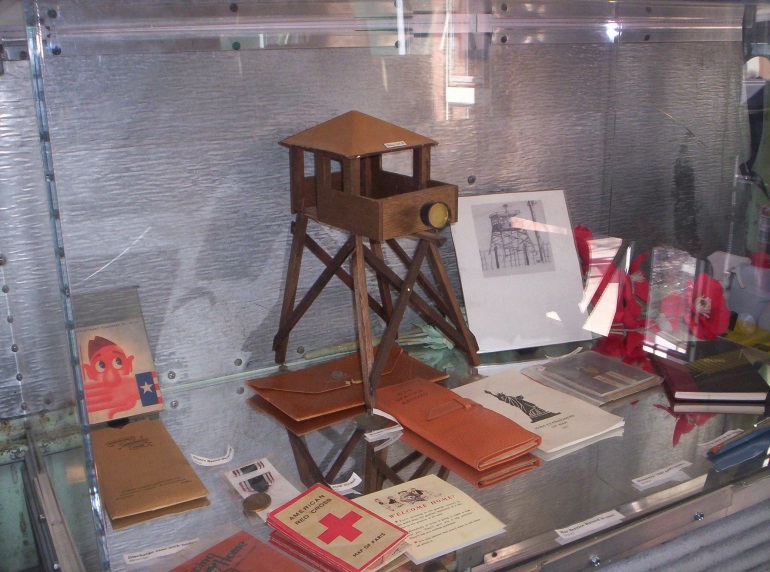
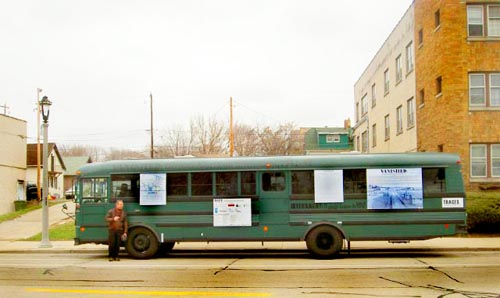

Staff: After a half-decade-long respite, Irving Kellman is again accompanying the BUS-eum around the Upper Midwest. He drove the two BUS-eums for several years (before stopping in 2010), across 25 U.S. states, to hundreds of showings, for tens of thousands of people. He later wrote of his role as docent-BUS driver: “It was one of the most challenging and gratifying jobs I ever had. I found it challenging, keeping a 40-foot-long bus going straight and being on time while navigating the winding and narrow paths of the back roads that comprise the heart of Mid-America; gratifying in meeting the wonderful and colorful people who populate those back roads.” He brings a unique perspective to the BUS as a son of Russian-Jewish immigrant parents, a former Civil-Rights volunteer in the Deep South working against segregation and, later, as a flower child in ‘60s-era San Francisco. He’s also worked as an art-house cinema manager, and on Mississippi, Ohio and Missouri River tug boats plying the Midwest. 
Irving Kellman 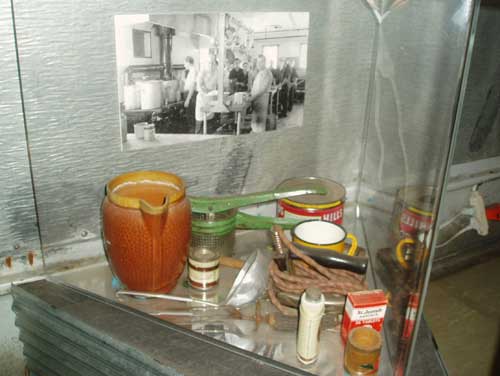
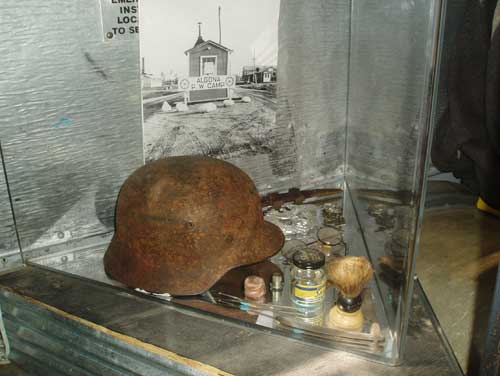
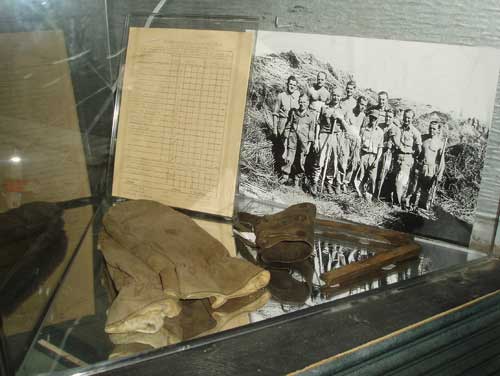
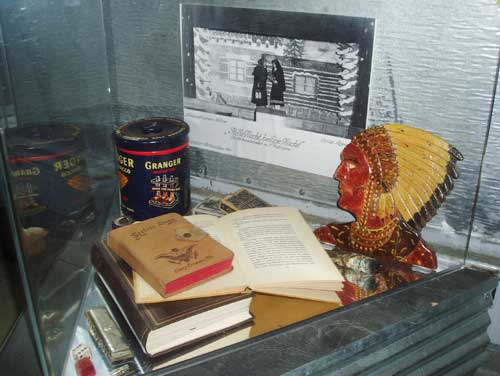
Having grown up on his family’s Century Farm in North Central Iowa, Michael Luick-Thrams is the recent author of his own family-history chronicle, Oceans of Darkness, Oceans of Light—a Pentalogy: Our Troubles and Treasures in the New World. (See http://www.amazon.com/s/ref=nb_sb_noss_2?url=search-alias%3Daps&field-keywords=roots+of+darkness for details.) His ancestors arrived in New England and Nieuw Amsterdam in 1630; they came to Iowa in the 1830s. The stories in this pentalogy take place in, among others, all Midwest states (Ohio, Michigan, Indiana, Illinois, Iowa, Wisconsin, Minnesota, the Dakotas, Nebraska, Kansas, Missouri), between 1785 and today.
Michael Luick-Thrams (Ph.D. in Modern European History from Humboldt Universität in Berlin) divides his time between Germany and Iowa, as he serves as executive director of a non-profit, educational organization in each country—Spuren e.V. (www.de.TRACES.org) & TRACES (www.roots.TRACES.org). Both provide social-history-based public programming to educational and cultural institutions of various kinds.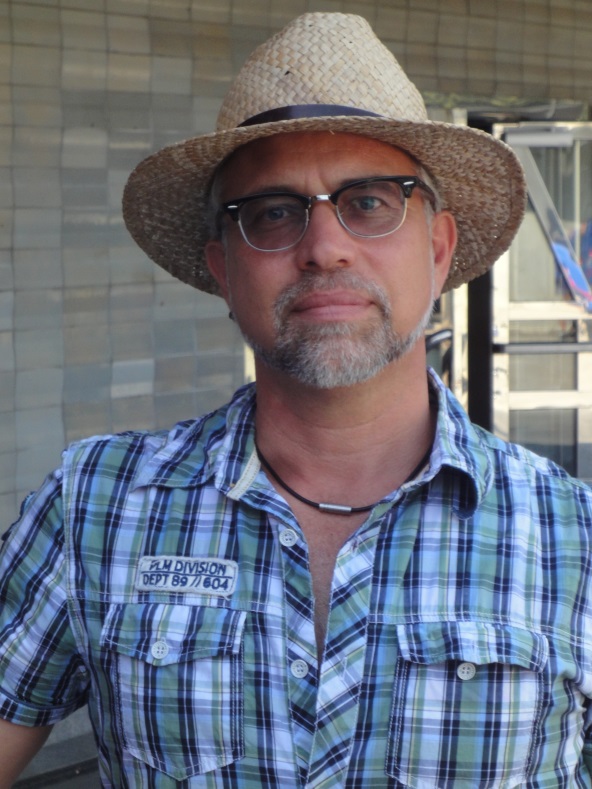
Michael Luick-Thrams